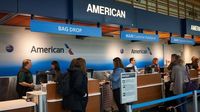It’s been a turbulent weekend for air travelers across the United States, with major airlines and airports grappling with a wave of delays and cancellations that left thousands of passengers stranded, frustrated, and searching for answers. The disruptions, which began in earnest on Friday, October 10, 2025, and continued through the weekend, have highlighted the fragility of the nation’s air travel system in the face of operational bottlenecks, staffing shortages, and unpredictable weather conditions.
According to data from FlightAware and reports from multiple news outlets, Friday marked a particularly challenging day for American Airlines, which logged a staggering 1,082 flight delays—impacting 30% of its total flights and ranking it second worldwide for delays, just behind Southwest Airlines, which topped the list with 1,589 delays. While American Airlines managed to keep cancellations relatively low at seven, the sheer volume of delays sent shockwaves through its operations and passenger itineraries alike.
But American was hardly alone in its struggles. Delta Air Lines experienced 876 delays on Friday, while United Airlines reported 705. The domino effect of these disruptions rippled across the country’s busiest airports, with Newark Liberty International, Chicago O’Hare, Hartsfield-Jackson Atlanta, Dallas-Fort Worth, and Miami International all recording hundreds of delayed departures and arrivals. As reported by The Herald and corroborated by other outlets, the chaos was not limited to any single airline or location; it was a nationwide phenomenon with global implications.
Saturday, October 11, 2025, brought little relief. Over 4,400 flights were delayed and more than 110 were canceled across the United States, creating widespread chaos at major hubs from Hawaii’s Daniel K. Inouye International to Boston Logan, Miami International, Denver, and beyond. The numbers were stark: 4,473 delays and 112 cancellations, impacting both domestic and international travelers. According to published statistics, American Airlines again found itself at the center of the storm, with 651 delays worldwide—affecting 19% of its flights—while Delta Air Lines recorded 562 delays and the highest number of cancellations among U.S. carriers at 44. United Airlines, too, was hit hard, with 531 delays.
Jetstar, JetBlue, Hawaiian Airlines, and other carriers were also named among those responsible for the mounting delays, as operational issues, weather challenges, and staffing shortages converged to create what many described as a perfect storm. The impact was felt acutely at the nation’s largest airports, but even smaller regional facilities like Schulz-Sonoma County in California saw disruptions. According to industry analysts, the scale of the delays underscored the ongoing vulnerabilities within the aviation sector, particularly as it adapts to surging demand and persistent workforce shortages.
“Travelers at airports such as Boston Logan, JFK, and Hartsfield-Jackson Atlanta faced significant delays as they waited for alternate flights, rebookings, and updates,” one report noted, capturing the sense of frustration and uncertainty that gripped terminals nationwide. Passengers found themselves caught in long lines, crowded waiting areas, and, in many cases, forced to miss connections or alter their plans entirely. The ripple effects extended far beyond the airports themselves, as families, businesses, and entire communities felt the economic and personal impact of the disruptions.
One particularly notable incident involved American Airlines flight 2732, which departed Charlotte Douglas International Airport at 2 p.m. on Friday, October 10, bound for Montego Bay, Jamaica. About 50 minutes into the flight, the plane turned back to Charlotte after two passengers refused to follow crew instructions—a situation that required the removal of the individuals from the aircraft. The flight eventually departed again at approximately 5:10 p.m., landing in Montego Bay around 6:46 p.m.—a full four hours later than originally scheduled. As The Herald reported, this was just one example of how non-operational issues can compound the challenges airlines face during periods of high disruption.
By Sunday morning, October 12, the situation showed faint signs of improvement, but the delays persisted. Delta Air Lines announced additional delays and canceled 26 flights, while Southwest Airlines had already delayed 70 flights. American Airlines, for its part, managed to keep its delay count lower at 46, affecting just 1% of its flights. Still, the cumulative effect of the weekend’s disruptions was undeniable, with more than 4,600 delays recorded within, into, or out of the United States on Saturday alone.
According to aviation experts and industry insiders, the causes of the weekend’s chaos were multifaceted. Operational issues at both the airline and airport levels played a significant role, as did weather-related challenges and, critically, ongoing staffing shortages. Many airlines have struggled to ramp up hiring and training to meet the surge in post-pandemic travel demand, leaving them vulnerable to even minor hiccups in scheduling or equipment availability. Maintenance challenges and high passenger volumes at key hubs only added to the strain.
The economic impact of these disruptions is significant, with airlines and airports facing not only direct financial losses but also the long-term risk of eroded consumer confidence. For passengers, the experience was a stark reminder of how quickly travel plans can unravel, and of the importance of monitoring flight status closely, understanding one’s rights, and preparing for the unexpected. As one industry report put it, “The thousands of delays and cancellations across major U.S. airports, along with the many hours spent in limbo by passengers, serve as a cautionary tale about the vulnerability of the aviation industry.”
Looking ahead, most analysts agree that airlines and airports must take proactive steps to address the root causes of these disruptions. This includes investing in advanced technologies to streamline operations, increasing staff levels, and upgrading infrastructure at key locations. Improved communication with passengers is also critical, especially as the holiday travel season approaches and demand for air travel is expected to remain high.
For now, travelers are advised to remain vigilant, check their flight status frequently, and know their rights in the event of delays or cancellations. While the skies may eventually clear, the events of this weekend have made it clear that the path to smooth air travel remains fraught with challenges—some predictable, others less so. As airlines, airports, and passengers alike look for solutions, the hope is that lessons learned from these disruptions will pave the way for a more resilient and reliable aviation system in the months and years to come.




